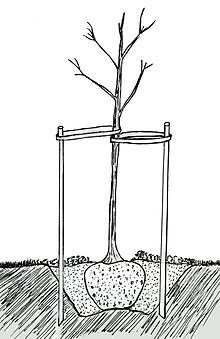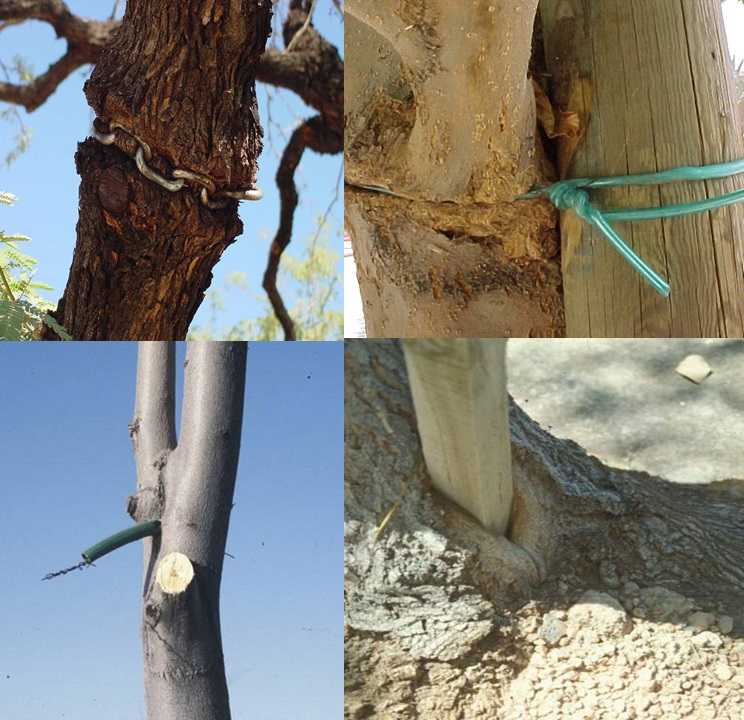 Staking Young Trees - May 4, 2016 Jeff Schalau, Agent, Agriculture & Natural Resources University of Arizona Cooperative Extension, Yavapai County Should you or should you not stake a newly planted tree? The answer depends on many factors. If the tree is in a commercial or park setting, then a tree may need staking for protection. Top-heavy trees, which are common in many container nurseries, require staking to prevent breakage and to strengthen the trunk. In moderately windy areas, a newly planted tree may need additional support simply to prevent it from blowing over. So, if trees need staking, why doesn't Mother Nature stake trees in the forest? To begin, letís review the natural history of a native tree. A seed of a suitable tree species germinates and develops into a sapling. For the first year or two, a wild-grown sapling puts most of its available energy into growing a substantial root system and resembles a shrub. This allows the tree to anchor and support itself while also exploiting a large volume of soil from which it can draw water and mineral nutrients. Once the root system is established, the tree can start to expand its energy collection system (leaves and branches) growing taller and wider. Where those branches grow, the energy produced by leaves above that point is directed back down that branch to increase the trunk girth in the area where that branch attaches to the trunk. Over time, lower branches are shaded by the upper branches, eventually causing the lower branches to die off. As this happens, the tree shifts from being a shrub to a tree. In nature, no stakes are needed. The top of the tree is supported by a well-developed root system and substantial trunk. Now, letís shift the setting to a residential landscape where, as always, the owner wants fast-growing, long-lived, trees to make summer shade and/or compliment the surrounding landscape. The nursery has several trees of suitable species to choose from and the owner purchases the appropriate trees for that landscape. What do these trees look like? They are often in ď15-gallonĒ containers with a small stake tied directly to the trunk with horticultural tape. These trees have a root system that is confined to a very small space and no side branches below four or five feet above the soil level. Many growers prune off the side branches to give the plant a tree-like appearance. These trees often have small trunk diameters, little or no trunk taper, and must be staked to support the top and prevent trunk breakage. The nursery industry is not to blame for these spindly trees. Rather, consumer preferences perpetuate these cultural practices. The average consumer wants that tall, straight tree that looks like a miniature version of the adult. They do not recognize that a shorter, shrub-like tree with a stout trunk is a better choice than an "instant tree". Short, stout trees will still have their side branches and should not require staking. However, until consumers become educated, the trees available will reflect popular preferences and therefore require staking. The online edition of this column (see URL below) has a publication with tree planting and staking specifications. Follow the planting guidelines using a shallow, wide planting hole, no amendments in the backfill, and mulch on the soil surface. Stake trees only if necessary. When you remove the nursery stake from the tree, does it stand up on its own? If not, drive two wooden tree stakes on either side of the tree perpendicular to the direction of the prevailing winds. Make sure stakes are driven at least six inches into undisturbed soil. To determine the height to place the ties, hold the trunk with one hand at various heights on the trunk. If the trunk leans over, move a few inches up and try again. Continue until you find the lowest point at which the tree will not bend over. Place ties at or slightly above this point. Attach only one tie to each stake. Some trunk movement is necessary to develop a strong trunk. The old-fashioned "wire threaded through a piece of garden hose" tree tie system is outdated and is often harmful to the tree. Rubber tree ties have been on the market for several years now as well. A new product, called ArborTie, is a polypropylene webbing that is tied around the tree using a unique knot and nailed or tied to the wooden stake and is the best tree tying system that Iíve seen. Whichever tie system is used, it should have the ability to move slightly from side to side. This allows the trunk to develop reaction wood, which strengthens the trunk. The tops of the stakes should be cut off below the canopy after tying to prevent rubbing on the lower branches. Inspect the stakes and ties periodically to prevent damage and assess the need for stakes. Generally, the stakes can be removed after one year. Follow the Backyard Gardener on Twitter Ė use the link on the BYG website. If you have other gardening questions, call the Master Gardener help line in the Camp Verde office at 928-554-8992 or e-mail us at verdevalleymg@gmail.com and be sure to include your name, address and phone number. Find past Backyard Gardener columns or provide feedback at the Backyard Gardener web site: http://cals.arizona.edu/yavapai/anr/hort/byg/.   Additional Resources Planting Guidelines: Container Trees and Shrubs University of Arizona Cooperative Extension extension.arizona.edu/sites/extension.arizona.edu/files/pubs/az1022.pdf To Stake or Not To Stake? Iowa State University Forestry Extension www.extension.iastate.edu/forestry/tree_planting/stake.html |